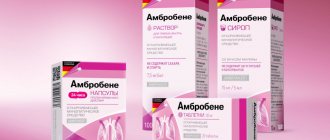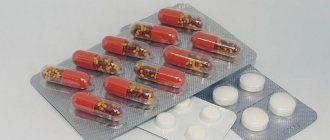Lazolvan cough remedy with sputum solution for oral administration and inhalation 100ml
A country
Italy
The country of production may vary depending on the batch of goods. Please check with the operator for detailed information when confirming your order.
Active substance
Ambroxol
Compound
1 ml of solution contains: active substance: ambroxol hydrochloride 7.5 mg Excipients: citric acid monohydrate 2 mg, sodium hydrogen phosphate dihydrate 4.35 mg, sodium chloride 6.22 mg, benzalkonium chloride 225 mcg, purified water 989.705 mg. Description Clear, colorless or slightly brownish solution Release form Solution for oral administration and inhalation 7.5 mg/ml. 100 ml in amber glass bottles with a polyethylene dropper and a polypropylene screw cap with first opening control. Each bottle is placed in a cardboard box with instructions for use and a measuring cup.
Pharmacological properties
Studies have shown that ambroxol, the active ingredient in Lazolvan®, increases secretion in the respiratory tract. It enhances the production of pulmonary surfactant and stimulates ciliary activity. These effects lead to increased mucus flow and transport (mucociliary clearance). Increasing mucociliary clearance improves sputum discharge and relieves cough. In patients with chronic obstructive pulmonary disease, long-term therapy with Lazolvan® (for at least 2 months) led to a significant reduction in the number of exacerbations. There was a significant decrease in the duration of exacerbations and the number of days of antibiotic therapy. Pharmacokinetics All dosage forms of immediate release ambroxol are characterized by rapid and almost complete absorption with a linear dose dependence in the therapeutic concentration range. Maximum plasma concentration (Cmax) after oral administration is achieved after 1-2.5 hours. The distribution volume is 552 l. In the therapeutic concentration range, binding to plasma proteins is approximately 90%. The transition of ambroxol from the blood to tissues when administered orally occurs quickly. The highest concentrations of the active component of the drug are observed in the lungs. Approximately 30% of the administered oral dose undergoes first pass through the liver. Studies in human liver microsomes have shown that CYP3A4 is the predominant isoform responsible for the metabolism of ambroxol to dibromoantranilic acid. The remainder of ambroxol is metabolized in the liver, mainly by glucuronidation and by partial breakdown to dibromanthranilic acid (approximately 10% of the administered dose), as well as a small number of additional metabolites. The terminal half-life of ambroxol is 10 hours. The total clearance is within 660 ml/min, renal clearance accounts for approximately 8% of the total clearance. Using the radioactive tracer method, it was calculated that after taking a single dose of the drug, about 83% of the dose taken is excreted in the urine over the next 5 days. No clinically significant effect of age and gender on the pharmacokinetics of ambroxol was found, so there is no basis for selecting the dosage based on these characteristics.
Indications for use
Acute and chronic diseases of the respiratory tract with the release of viscous sputum: acute and chronic bronchitis, pneumonia, chronic obstructive pulmonary disease, bronchial asthma with difficulty in sputum discharge, bronchiectasis.
Contraindications
Hypersensitivity to ambroxol or other components of the drug, pregnancy (first trimester), lactation period. Use Lazolvan® with caution during pregnancy (II–III trimester), with renal and/or liver failure. Use during pregnancy and breastfeeding Ambroxol penetrates the placental barrier. Preclinical studies have not revealed direct or indirect adverse effects on pregnancy, embryonic/fetal, postnatal development and labor. Extensive clinical experience with the use of ambroxol after the 28th week of pregnancy has found no evidence of a negative effect of the drug on the fetus. However, normal precautions must be taken when using the medicine during pregnancy. It is especially not recommended to take Lazolvan® in the first trimester of pregnancy. In the second and third trimesters of pregnancy, the use of the drug is possible only if the potential benefit to the mother outweighs the potential risk to the fetus. Ambroxol can be excreted in breast milk. Despite the fact that no undesirable effects were observed in breast-fed children, it is not recommended to use Lazolvan® solution for oral administration and inhalation during lactation. Preclinical studies of ambroxol did not reveal any negative effects on fertility.
Mode of application
Inside. Oral administration (1 ml = 25 drops). Adults and children over 12 years old: 4 ml (= 100 drops) 3 times a day; Children from 6 to 12 years old: 2 ml (= 50 drops) 2-3 times a day; Children from 2 to 6 years: 1 ml (= 25 drops) 3 times a day; Children under 2 years old: 1 ml (= 25 drops) 2 times a day. Drops can be diluted in water, tea, juice or milk. The solution can be used regardless of meals. Inhalations Adults and children over 6 years of age: 1-2 inhalations of 2-3 ml of solution per day. Children under 6 years of age: 1-2 inhalations of 2 ml of solution per day. Lazolvan®, solution for inhalation, can be used using any modern equipment for inhalation (except for steam inhalers). To achieve maximum hydration during inhalation, the drug is mixed with 0.9% sodium chloride solution in a 1:1 ratio. Since during inhalation therapy a deep breath can provoke a cough, inhalations should be carried out in normal breathing mode. Before inhalation, it is usually recommended to warm the inhalation solution to body temperature. Patients with bronchial asthma are recommended to carry out inhalation after taking bronchodilators to avoid nonspecific irritation of the respiratory tract and their spasm. If symptoms of the disease persist within 4-5 days from the start of treatment, it is recommended to consult a doctor.
Side effect
Gastrointestinal disorders Often (1.0 – 10.0%) – nausea, decreased sensitivity in the mouth or pharynx; Uncommon (0.1 - 1.0%) - dyspepsia, vomiting, diarrhea, abdominal pain, dry mouth; Rarely (0.01 – 0.1%) – dry throat. Immune system disorders, damage to the skin and subcutaneous tissues Rarely (0.01 - 0.1%) - skin rash, urticaria; anaphylactic reactions (including anaphylactic shock)1, angioedema1, itching1, hypersensitivity1. Nervous system disorders Often (1.0 - 10.0%) - dysgeusia (impaired sense of taste). 1 - these adverse reactions were observed with widespread use of the drug; with a 95% probability, the frequency of these adverse reactions is uncommon (0.1%-1.0%), but possibly lower; The exact frequency is difficult to estimate as they have not been reported in clinical studies.
Overdose
Specific symptoms of overdose in humans have not been described. There have been reports of accidental overdose and/or medical error resulting in symptoms of known side effects of Lazolvan®: nausea, dyspepsia, vomiting, diarrhea, abdominal pain. In this case, there may be a need for symptomatic therapy. Treatment: artificial vomiting, gastric lavage in the first 1-2 hours after taking the drug, symptomatic therapy.
Interaction
No clinically significant, undesirable interactions with other drugs have been reported. Increases the penetration of amoxicillin, cefuroxime, and erythromycin into the bronchial secretions.
special instructions
It should not be combined with antitussives that make it difficult to remove sputum. The solution contains the preservative benzalkonium chloride, which, when inhaled, may cause bronchospasm in sensitive patients with increased respiratory tract reactivity. Lazolvan® solution for oral administration and inhalation is not recommended to be mixed with cromoglycic acid and alkaline solutions. An increase in the pH value of the solution above 6.3 may cause precipitation of ambroxol hydrochloride or the appearance of opalescence. Patients on a hyposodium diet should take into account that Lazolvan® solution for oral administration and inhalation contains 42.8 mg of sodium in the recommended daily dose (12 ml) for adults and children over 12 years of age. There are isolated reports of severe skin lesions, such as Stevens-Johnson syndrome and toxic epidermal necrolysis, coinciding with the administration of expectorants such as ambroxol hydrochloride. In most cases, they can be explained by the severity of the underlying disease and/or concomitant therapy. Patients with Stevens-Johnson syndrome or toxic epidermal necrolysis may present with fever, body aches, rhinitis, cough, and sore throat in the early phase. With symptomatic treatment, it is possible to erroneously prescribe anti-cold medications. If new lesions of the skin and mucous membranes appear, it is recommended to stop treatment with ambroxol and immediately seek medical help. If renal function is impaired, Lazolvan® should be used only on the recommendation of a doctor. Effect of the drug on the ability to drive vehicles and machinery. There were no cases of the drug influencing the ability to drive vehicles and machinery. Studies on the effect of the drug on the ability to drive vehicles and engage in other potentially hazardous activities that require increased concentration and speed of psychomotor reactions have not been conducted.
Use of the drug Lazolvan
The following dosage regimen is recommended: tablets. Adults and children over 12 years of age: 1 tablet 3 times a day. The therapeutic effect can be increased by using 2 tablets 2 times a day. The tablets should be taken after meals and washed down with water. The duration of treatment depends on the nature of the disease and the effectiveness of the therapy. Syrup. Adults and children over 12 years of age: 10 ml (2 teaspoons) 2 times a day. The syrup is recommended to be consumed with meals. Treatment period is up to 14 days. You should consult your doctor if symptoms of the disease last more than 14 days and/or worsen despite taking Lazolvan syrup. Capsules. Adults: 1 capsule is the daily dose; it should be taken in the morning or evening after meals. Capsules must be swallowed whole, without chewing, with plenty of liquid. Treatment period is up to 14 days. You should consult your doctor if symptoms of the disease last more than 14 days and/or worsen despite taking Lazolvan Retard capsules.
Side effects of the drug Lazolvan
As a rule, taking Lazolvan is well tolerated. Gastrointestinal disorders: mild manifestations of heartburn, dyspepsia, nausea, vomiting, diarrhea; disorders of the immune system, skin and subcutaneous tissues: skin rash, urticaria, angioedema, anaphylactic reactions (including anaphylactic shock) and allergic reactions. If lesions of the skin or mucous membranes progress, you should immediately consult a doctor and stop treatment with ambroxol. Severe skin lesions, such as Stevens-Johnson and Lyell syndromes, have been reported extremely rarely in association with the use of mucolytic agents such as ambroxol. As a rule, they could be explained by the severity of the underlying disease or the use of concomitant medications.
Special instructions for the use of the drug Lazolvan
Use during pregnancy and lactation. Ambroxol penetrates the placental barrier. Animal studies have not revealed direct or indirect negative effects on pregnancy, embryo/fetal development, childbirth or postnatal development. Extensive clinical experience with use after the 28th week of pregnancy has found no evidence of negative effects on the fetus. Despite this, the usual precautions should be followed when using medications during pregnancy. The use of Lazolvan is not recommended, especially in the first trimester of pregnancy. Ambroxol passes into breast milk. Therefore, Lazolvan is not recommended to be taken during breastfeeding. However, one should not expect a negative effect on an infant if the mother takes Lazolvan during breastfeeding. Lazolvan tablets contain 684 mg of lactose in the maximum recommended daily dose (120 mg). Patients with a rare form of hereditary galactose intolerance, Lapp lactose intolerance or glucose-galactose malabsorption should not take this drug. Lazolvan syrup does not contain sugar, so it can be prescribed to patients with diabetes; the syrup does not contain alcohol. Children under 12 years of age are recommended to use Lazolvan in the form of syrup. Residues of gelatin capsules, sometimes detected in feces, do not indicate the ineffectiveness of the drug (the active substance is released from the capsules during passage through the digestive tract). This dosage form, namely Lazolvan Retard extended-release capsules, should not be prescribed to children.


